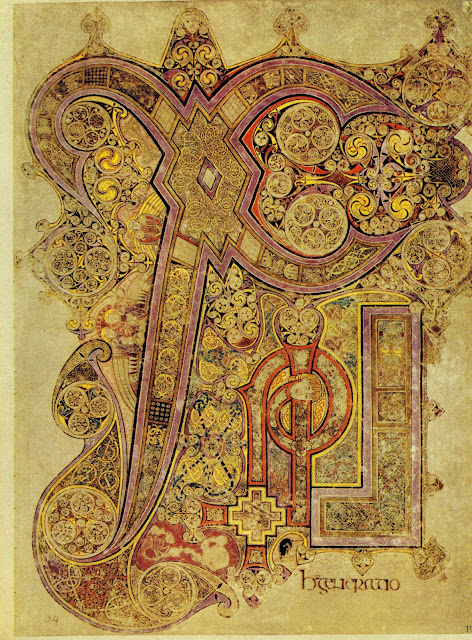The Book of Kells is a stunningly beautiful manuscript containing the Four Gospels.
The text of the Gospels is largely drawn from the Vulgate, although it also includes several passages drawn from the earlier versions of the Bible known as the Vetus Latina.
It is Ireland's most precious medieval artifact, and is generally considered the finest surviving illuminated manuscript to have been produced in medieval Europe.
 |
| Christ Enthroned - Book of Kells |
The Book of Kells was probably produced in a monastery on the Isle of Iona, Scotland, to honour Saint Columba in the early 8th century, and continued at the monastery of Kells in Ireland where it was removed after a viking raid in Iona during the 9th century.
Although the question of the exact location of the book's production will probably never be answered conclusively, it is certain that the Book of Kells was produced by Columban monks closely associated with the community at Iona.
 |
| Madonna and Child - Book of Kells |
It was stolen in the 11th century, at which time its cover was torn off and it was thrown into a ditch. The cover, which most likely included gold and gems, has never been found, and the book suffered some water damage; but otherwise it is extraordinarily well preserved.
 |
| Gospel of Matthew opening "Chi-Rho" page - Book of Kells |
The Book of Kells was written on vellum (calfskin), which was time-consuming to prepare properly but made for an excellent, smooth writing surface. 680 individual pages, that is 340 folios, have survived, and of them only two lack any form of artistic ornamentation.
In addition to incidental character illuminations, there are entire pages that are primarily decoration, including portrait pages, "carpet" pages and partially decorated pages with only a line or so of text.
 |
| Gospel of Mark opening page - Book of Kells |
The illustrations and ornamentation of the Book of Kells surpass that of other Insular Gospel books in extravagance and complexity.
The decoration combines traditional Christian iconography with the ornate swirling motifs typical of Insular art. Figures of humans, animals and mythical beasts, together with Celtic knots and interlacing patterns in vibrant colours, enliven the manuscript's pages.
Many of these minor decorative elements are imbued with Christian symbolism and so further emphasise the themes of the major illustrations.
 |
| Four Evangelists - Book of Kells |
As many as ten different colours were used in the illuminations, some of them rare and expensive dyes that had to be imported from the continent.
The workmanship is so fine that some of the details can only be clearly seen with a magnifying glass.
 |
| Genealogy of Christ - Book of Kells |
In 1541, at the height of the English Reformation, the book was taken by the Roman Catholic Church for safekeeping.
It was returned to Ireland in the 17th century, and Archbishop James Ussher gave it to Trinity College, Dublin, where it resides today.
 |
| Eusebian Canon Table - Book of Kells |